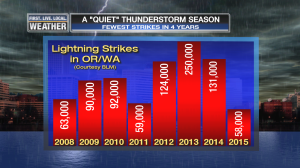One month ago the Pacific Northwest fire situation was bleak with almost one million acres burning in Oregon and Washington forests and range lands. But today, what few fires left are just smoldering and no significant acreage has burned in many days.
We’ve known since mid-spring we could be facing a very bad fire season…consider the setup for the “PERFECT FIRE SEASON”
- Moderate to severe drought across much of the region has continued from one to several years
- The worst snowpack in MANY decades last winter/spring for much of the region’s mountains.
- Temperatures were warmer than normal from winter through early summer; causing what little snowpack remained to melt quickly. Soils dried out quickly as well.
- June was the warmest on record for much of the Pacific Northwest, with a severe heatwave at the end of the month. Remember the 110+ temps in the Columbia Basin?
By late June, during that big heatwave that went on for about two weeks, I figured it was going to be REALLY BAD in July and August. But July came and went without any big blowup of fires. As of late July, acreage burned across the Pacific Northwest was below normal!
What happened? We were blessed, or lucky, or whatever you want to call it, by two big changes from previous fire season
1. Far less lightning this summer
Take a look at the past 8 years worth of lightning strikes in Oregon and Washington:

So far, less than half what we saw in 2014, and only 25% of the action two summers ago! And according to the BLM the largest “event” consisted of just 6,400 strikes. The past two summers we saw peak events in the 21,000 to 38,000 strike range.
2. Cool with rain late August/September
What a change from warmer than normal to a bit cooler than normal in September! Quite a refreshing month. We’ve gone through 4 warm/hot Septembers and now it’s payback time. Note we’ve seen the fewest 80 degree days this month since 2010.

There hasn’t been a ton of rain, but several showery periods east of the Cascades along with snow at mid-month above about 6,000′ in Eastern Oregon has done the trick!
This is how the acreage burned looked as we went through the fire season (thanks to the BLM folks, click for a larger view):

Note the below normal numbers, then the huge jump in August, then leveling out in September. We’re pretty much done with fire season now. Of course we can still get fires in October, but not the huge ones we see in the summer.
One more interesting chart, showing the acres burned per week:

You see the weekly numbers jump in mid-late August, then a big crash. I don’t understand why there is a jump of 150,000 acres only a week or two ago because I don’t remember any big new fires during that period.
In the end, Fire Season 2015 will end up with above normal acreage burned…definitely a big fire season with lots of homes burned. But almost all the action happened during a one month period in August. I think it could have been far worse!
Chief Meteorologist Mark Nelsen





 Posted by Mark Nelsen
Posted by Mark Nelsen 



















